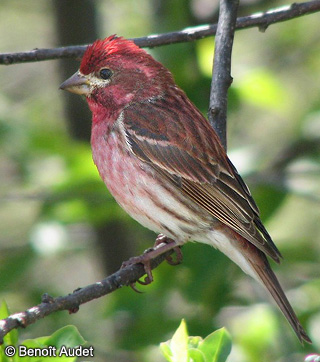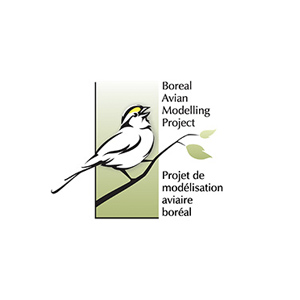THE BOREAL AVIAN MODELLING PROJECT
SFI Supports Research to Help Billions of Birds in the Boreal Forest
Why This Project Matters

The boreal forest, stretching from Alaska to Newfoundland is an important global bastion of bird life and billions of birds migrate to and from the boreal forest every year from as far away as South America. They can face threats all along these massive flyways. With our North American scale SFI hopes to proactively and positively influence bird conservation on managed, working-forest landscapes.
The Canada warbler, for example, flies back and forth from the northern Andes to the boreal forest. In Canada, where about 80% of the Canada warbler’s global breeding range is located, it breeds in all provinces and territories. It is listed as a threatened species under Canada’s Species at Risk Act (SARA). A grant, from the SFI Conservation and Community Partnerships Grant Program, is helping the Canada warbler, and all boreal birds, by supporting the University of Alberta’s Boreal Avian Modelling (BAM) Project.
How the Project Helps Conserve Biodiversity
The BAM project is a partnership of many organizations led by the University of Alberta, Université Laval and Environment and Climate Change Canada, the broader partnership includes academic institutions, government agencies and environmental NGOs. BAM was created to develop models that will help managers, including forest managers, understand which habitats birds need for breeding. This work will meet immediate conservation needs and inform future research and monitoring efforts. The results generated by BAM are relevant to anyone with an interest in the conservation of over 300 species of birds found in the boreal.
For example, BAM data on the olive-sided flycatcher, which is listed as threatened under SARA, is being used in the Alberta Land Use Framework and other land-use planning exercises to understand how changes in forest age and type will influence it and other birds’ breeding habitats. These types of land-use scenario models will aid in the development of regional management plans that feed into provincial conservation and stewardship strategies for private and public lands.
How the Project Helps Forest Managers
The BAM project will investigate conservation management needs of SFI Program Participants and other forestland managers. In the case of the brown creeper, for example, preliminary data show the birds have a strong preference for nesting in dead or dying trees. Whereas some birds like the Lincoln’s Sparrow and the pine siskin are common in harvested areas.
BAM data also have the potential to inform land managers of a range of bird habitat needs. This data could help guide management decisions at a landscape and stand level, including forests of exceptional conservation value. BAM data has the potential to enhance implementation of stand- and landscape-level measures that promote a diversity of habitat types, which is a requirement under the SFI 2015-2021 Forest Management Standard.
SFI’s contribution
SFI has developed strong partnerships across North America to enhance forest bird conservation. Our work with BAM is the latest in one of many bird conservation projects. Working with BAM will allow SFI Program Participants to scale up work to a national level, and perhaps inform continental conservation of some species. This will complement the work of a range of SFI partners in establishing and enhancing the conservation value of SFI lands for forest birds.
The project is also directly supported by SFI Program Participants Canfor, Louisiana-Pacific, West Fraser and Weyerhaeuser. These companies will provide in-kind data support to help BAM in characterizing the conservation value of their certified land base. These partners will also contribute data expertise and analysis coordination.
This partnership cuts across government, academia, conservation NGO’s and industry to provide strategic coordination around large-scale conservation efforts focused on bird habitat and breeding patterns. These partners include:
Partners
- Project lead: University of Alberta
- Sustainable Forestry Initiative
- American Bird Conservancy
- Bird Studies Canada
- Canadian Wildlife Service
- Canfor (SFI Program Participant)
- Ducks Unlimited Canada
- Louisiana-Pacific (SFI Program Participant)
- Nature Canada
- Université Laval
- University of British Columbia
- West Fraser (SFI Program Participant)
- Weyerhaeuser (SFI Program Participant)

About Boreal Avian Modelling Project
The Boreal Avian Modelling Project is a collaborative science program committed to improved understanding of the ecology of birds and their habitats in the boreal region of North America.
Using quantitative modelling techniques and a comprehensive dataset assembled from projects across the continent, we derive information on abundance, distribution and habitats of boreal birds, and use this to evaluate and predict the effects of human activity.
Related Information
- SFI supported a Canada warbler workshop for conservationists and resource managers convened by Nature Canada. Media release.
- American Bird Conservancy wins SFI President’s Award for putting SFI’s scale to work for birds. Media release.
- Greg Siekaniec, former CEO of Ducks Unlimited Canada, has an op-ed in the Vancouver Sun, « Opinion: Protecting the treasure that is Canada’s boreal forest. »
- Ducks Unlimited Canada wins SFI President’s Award for leadership in forest conservation and community objectives. Media release.
Share
COPY LINK: https://forests.org/grantborealavianmodelling/